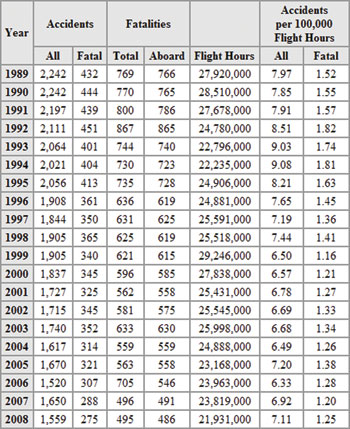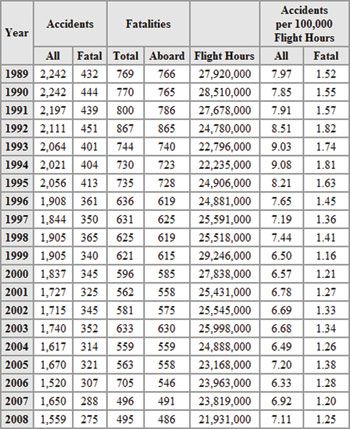The NTSB in early April released preliminary general aviation accident data for 2008. No one should be happy. For example, there were 1559 accidents involving Part 91 operations, 275 of which involved fatalities. Those fatal accidents killed a total of 495 persons, one fewer than the previous year. One. After all the training improvements, the influx of new, well-equipped aircraft, all the new, high-tech equipment being installed in older ones, after weather-forecasting and observation enhancements on the ground and in the air, only one. 350 And the accident rate jumped up, from 6.92 accidents per 100,000 hours in 2007 to 7.11 in 2008. This is despite an overall reduction in accidents, from 2007s 1650 to 1559 last year, and stems from fewer flying hours, a reduction of almost 10 percent. These results are pretty sorry for an industry desperate to be taken seriously. Looking backward, 2006 was a very good year, with an overall increase in flight hours and a 20-year low in the accident rate. But 2006 also came with a huge spike in fatalities, from 563 in 2005 to 705. On its face, there are no easily identified reasons for these poor numbers. One could argue 2008s high fuel prices sharply reduced flight hours and, instead of cutting back on business and personal transportation, we flew fewer training and proficiency missions. If so, that didnt work out too well. And it gets worse: 2008s Part 135 numbers show 56 accidents killing 66 people, “the highest number of fatalities since 2000,” per the NTSB. Thankfully, Part 135 operators did manage an accident rate (1.52) virtually unchanged from 2007s 1.54. I was recently asked if general aviation is safe. Its a relative question, of course, and my response went something like this: If you look at the entire universe of non-scheduled, civilian flight operations and remove from it things like bush flying, flight-testing, aerial application, buzzing an ex-spouses home and the like, and concentrate on well-maintained aircraft flown by proficient pilots in manageable weather, yes, GA is a very safe transportation mode. And I think the record supports me. The problem, of course, is when we stray from these qualifiers, as we apparently did for much of 2008. What makes my head explode is this stuff isnt rocket science. Carry enough fuel for the flight, plus reserves. Avoid weather for which youre not trained or prepared. Ensure the aircraft has no outstanding maintenance issues. Use landing areas appropriate to the aircrafts performance and your ability. Can we all try these things during 2009 and see how it works out in a year or so? – Jeb Burnside




